Moroccan cuisine is influenced by Morocco’s interactions and exchanges with other cultures and nations over the centuries, with Mediterranean, Arabic, Andalusian and Berber cuisines. Berber is a term that comes from the Roman word for “barbarian” and today refers to a very large group of people from North Africa, living in a space that spans from the Atlantic Ocean to the Nile River. Now concentrated in Morocco and Algeria, this group is generally regarded as desert nomads and is comprised of numerous languages and ethnic groups. Berbers call themselves i-Mazigh-en: free people. Much of the population of North Africa is less Arab and more Berber, particularly when you venture out from the cities. Morocco takes a lot of its culinary influences from Berber nomad, as well as Arabic influences that have diffused throughout North Africa, and here is a list of foods that are common staples as well as foods for more special occasions.
Breads
The hearty and varied breads of Morocco compose an essential part of the region’s daily cuisine. Even the Berbers, one of the major tribes prevalent in the country from the Rif Mountains of the north, would sustain themselves with bread made from barley. While wandering through the marketplaces or the various “souks”, one can typically find local women baking fresh breads for sale made from sorghum, millet, barley, or wheat. Moroccans can be spotted everyday carrying large packets of bread home from the market.
Khobz is a type of bread that can be made from both white or whole wheat flour. It is a daily staple across a lot of North Africa and can be infused with anise seeds, carraway, thyme, and other spices and herbs. It accompanies every meal and during a traditional Moroccan meal, khobz often replaces utensils such as forks or spoons as it is used to scoop up meat, vegetables, sauce, salads, dips and more.

Khobz white bread baked from the previous day is scattered outside the doors of the marketplace for dogs and mules to feed on.
Beghrir is an ancient Berber pancake. It is tender and spongy and is made with semolina or flour. When correctly cooked, the yeast in the crepe-like batter will cause the beghrir to be riddled with small holes which soak up the sauces that they are served with. This is what gives it its unique texture and appearance. The most common way to eat baghrir in Algeria and Morocco is by dipping them in a honey-butter mixture, but they can also be cut into wedges and served with jam. It is common to add raisins to the pancake as well. This dish is enjoyed at breakfast, as a snack, or at Iftar during the holy month of Ramadan.
Msemen is a traditional Arabic pancake-like, flattened, layered bread. It is made from flour, semolina, dry yeast, melted butter, salt, sugar and a bit of water. These are mixed well together into a smooth dough mixture. The dough is cut into several balls, which are then rolled out and folded into square pancakes, and then fried. This is also a common dish across the Middle East and Asia, and in India, it is called a parata. It can also be stuffed with vegetables or meat.

Msemen – flattened square-shaped bread. The dough is kneaded like bread dough until soft and smooth and then fried.
Harcha is a Moroccan pan-fried bread made from semolina. It has a corn-bread like texture and uses butter and milk. It is delicious when hot from the griddle and eaten with some jam, cheese or syrup made from melted butter and honey, and served from breakfast or tea.

Harcha – pan-fried bread made from semolina. Although it looks a bit like an English muffin, it’s more like cornbread in texture and taste.
Harira Soup
This traditional Moroccan soup is traditionally served during Ramadan but has become a staple snack throughout the year. It is made from Tadouira – a thickening mixture made from flour and water and sometimes canned tomato paste, which is added to the end of the harira cooking process, tomatoes, lentils, chickpeas, onions, rice, beaten eggs, herbs like parsley, celery and coriander, olive oil, and lemon juice. It is often served with It is usually served with hard-boiled eggs sprinkled with salt and cumin, dates and other favorite dried fruits like figs, traditional honey sweets and other home-made special breads or crepes. It is served with dates or bread or some slices of lemon.
Tagine
Tagine is probably the most popular dish of Moroccan cuisine. Named aptly after the cooking earthenware pot it is made in, this staple typically comprises of various meat and vegatable combinations of which we tried lamb with prunes, lamb with apricots, stewed chicken with steamed vegetables, and fish with bell peppers and other legumes. The tagine’s conical shape makes a uniquely moist, hot cooking environment for the dish being cooked. The base is wide and shallow, and the tall lid fits snugly inside. As the food cooks, steam rises into the cone, condenses, and then trickles down the sides back into the dish. While tagine stews are definitely the most popular and well-known dish to make in a tagine, this dish can be used for rice and couscous too.
Pastilla
Pastilla was created in Andalucia during the Umayyad Caliphate and was originally called Judhaba before it got its name. This dish was a favorite of the Moroccan sultan of Fes and is the national dish of the city today. This dish is an elaborate meat pie traditionally made of fledgling pigeons slow-cooked in broth and spices, crepe-like werqa or phyllo dough which is fragile and must be worked with quickly for the right consistency, and a crunch layer of toasted and ground almonds, cinnamon and sugar. This is what makes this dish uniquely savory and sweet at the same time. It is typically served as a second course in a meal after Harira soup. The filling must be typically made a day in advance by browning the meat pieces and combining it with oil, onions, water, parsley and various spices. In a round pizza pan, the first dough layer is added and the chef will add the sauce consisting the of the filling and will place two more sheets of dough before baking it. The final presentation is sprinkled with sugar and cinnamon. Nowadays, the dish is made with shredded chicken rather than pigeon as fewer people are as willing to eat pigeon (as we discovered the hard way at a street cafe where we tried to order pigeon pastilla which took two hours to prepare before we realized that the waiter had run out to buy a pigeon from the souq to prepare it for us…deceptively. It was delicious anyways.)

Pastilla – It is a pie which combines sweet and salty flavours; a combination of crisp layers of the crêpe-like werqa dough (a thinner cousin of the phyllo dough), savory meat slow-cooked in broth and spices and shredded, and a crunchy layer of toasted and ground almonds, cinnamon, and sugar.

Pigeon Pastilla – it took two hours to make on account of our waiters personally going out to the market to find a pigeon.

Shredded chicken is more often used today as pigeon is less common to find and fewer people are willing to eat its meat. Pastilla is generally served as a starter at the beginning of special meals.
Couscous
Couscous is a North African Berber dish made of tiny steamed balls of semolina and is usually served with stew ladled on top or with vegetables and meat as shown in the picture below. The word couscous is generally thought to derive from one of the Berber dialects because it does not take the article indicating a foreign language origin. It has also been suggested that the word derives from the Arabic name for the perforated earthenware steamer pot used to steam the couscous, called a kiskis.

Couscous – small steamed balls of Semolina – originating from Berber cuisine served with steamed and stewed vegetables such as zucchini, carrots, potatoes and raisins.
Berber Omelet
The Moroccan Berber omelet originates from the deserts of North Africa and is also prepared in a tagine clay pot. It is made with eggs, tomatoes, onions, garlic, pepper, salt paprika, coriander, parsley, and olives. It is similar to the Middle Eastern version of the dish shakshouka, which is typically served for breakfast. It is different from a regular omelet in that it retains a more liquid consistency like the other tagine stews.

Moroccan Berber omelet, a vegetarian dish of eggs poached in a rich tomato sauce cooked in a traditional tagine
Brochettes
Usually reserved for special occasions, most notably in the days following Eid Al-Adha, brochettes are like kebabs that are made with pricier, extra tender cuts of meat such as leg of lamb or fillet of steak. They are served as an entrée, as part of a multi-course meal, or as a sandwich filler with some Khobz bread. The traditional seasoning below includes lots of onion, herbs and zesty amounts of paprika, cumin, salt and pepper.
Mint Tea
Mint tea (in Arabic, شاي بالنعناع, shāy bil n’anā’, or more commonly, in dialect, التاي, it-tay) is central to social life in Morocco. The serving can take a ceremonial form, especially when prepared for a guest. The tea is traditionally made by the head male in the family and offered to guests as a sign of hospitality. Typically, at least three glasses of tea are served, and it is considered impolite to refuse it. The tea is consumed throughout the day as a social activity, with tea bars filling a similar social function to alcohol drinking establishments in Europe and North America.

The tea being prepared by the host in a traditional Moroccan home. The process is more exhaustive than it looks with multiple filtering done through the large copper kettle.

Slurped down my delicious mint tea! Many Moroccans will actually slurp the tea to create pockets of air that cool the tea so that the mouth will not get burnt. It is not considered rude in this culture!









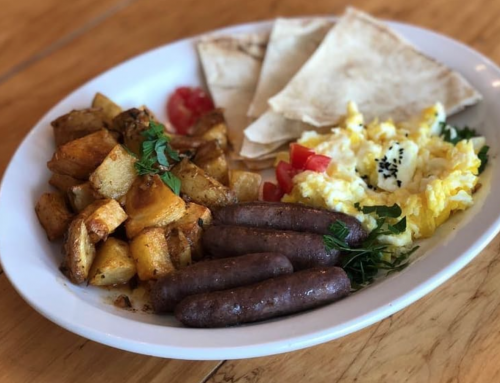
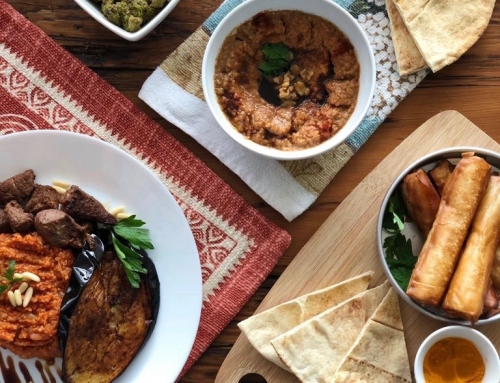
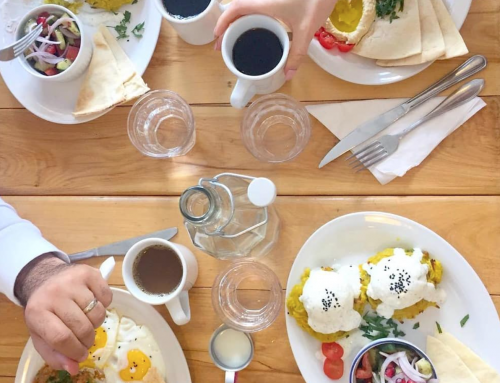
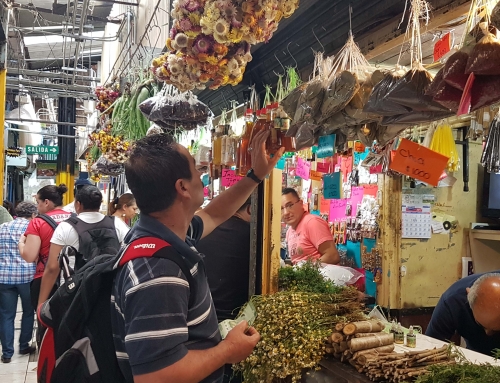
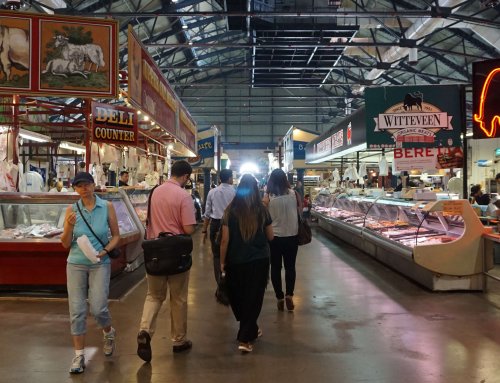






Leave A Comment